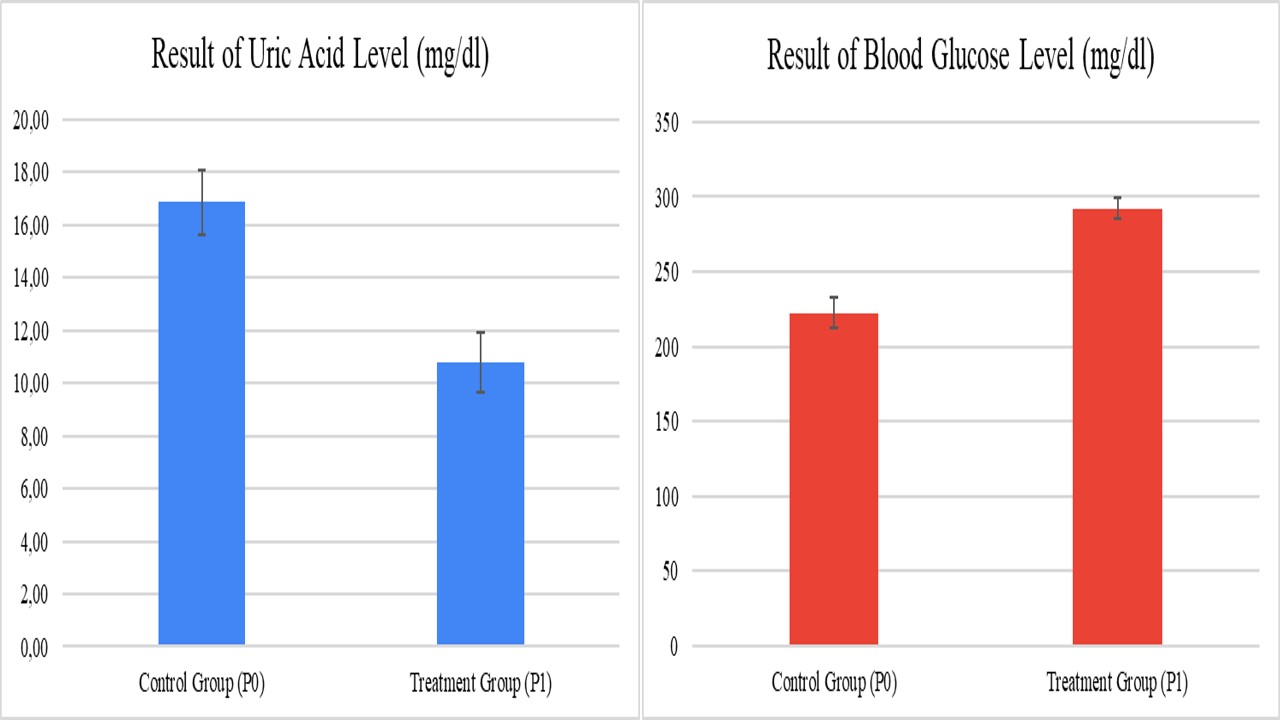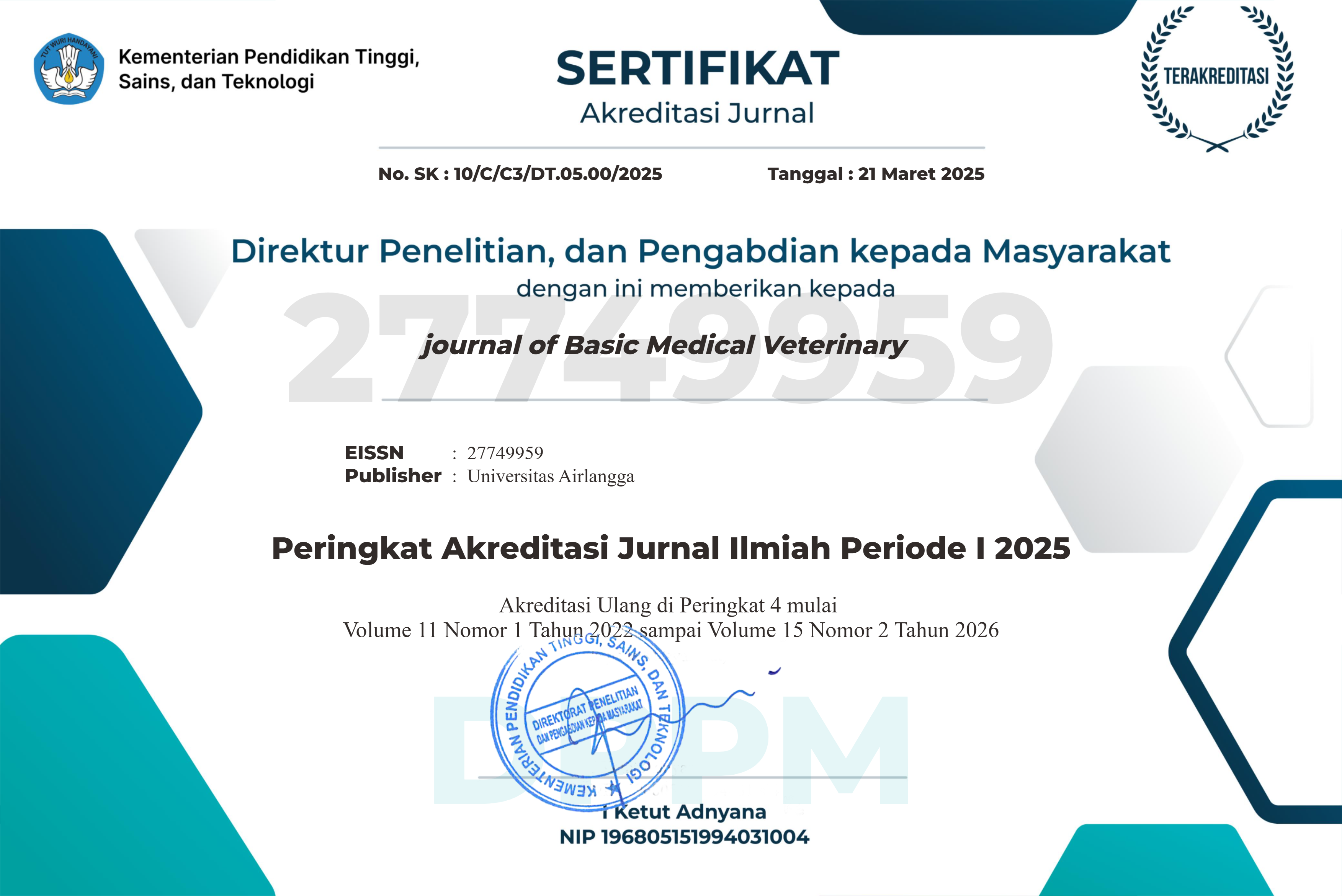Effect of Excessive Carrot Juice (Daucus carota) Administration on Uric Acid and Blood Glucose Levels in Rats (Rattus norvegicus)

Downloads
The consumption of carrot juice (Daucus carota) has been associated with various health benefits, yet its effects on metabolic parameters such as uric acid and blood glucose levels remain inadequately explored. Understanding these effects is crucial for developing dietary recommendations, particularly for conditions related to elevated uric acid and blood glucose. This research aimed to investigate the impact of excessive carrot juice administration on uric acid and blood glucose levels in rats (Rattus norvegicus). The study sought to determine whether carrot juice could serve as a beneficial dietary intervention or if it posed risks for metabolic dysregulation. A true experimental design was employed, utilizing a post-test only control group approach. Four healthy rats were divided into two groups: a control group receiving standard rat feed and a treatment group receiving carrot juice alongside their feed for seven days. Blood samples were collected after a 12-hour fasting period, and uric acid and blood glucose levels were measured using an Easy Touch GCU glucometer. Statistical analysis included descriptive statistics and T-tests to assess significant differences between groups. The results indicated that excessive administration of carrot juice significantly decreased uric acid levels in the treatment group compared to the control group (p < 0.05). Conversely, blood glucose levels were found to be significantly higher in the treatment group (p < 0.05), suggesting a complex interaction between carrot juice consumption and metabolic regulation. The study concludes that while excessive carrot juice can effectively lower uric acid levels in rats, it may also lead to increased blood glucose levels. These findings highlight the need for cautious dietary recommendations regarding carrot juice intake, particularly for individuals at risk of hyperglycemia. Future research should focus on larger sample sizes and explore the effects of carrot juice on various physiological systems and stress-related impacts on metabolic parameters.
Adelina, R., Noorhamdani, N. and Mustafa, A., 2016. Perebusan dan penumisan menurunkan kandungan beta karoten dalam wortel. Jurnal Gizi Dan Dietetik Indonesia (Indonesian Journal of Nutrition and Dietetics), 1(3), pp.164-168.
Fadii, R., 2024. Ketahui berbagai nutrisi dan manfaat wortel untuk kesehatan. Halodoc. Retrieved 22 October 2024, from https://www.halodoc.com/artikel/inilah-kandungan-nutrisi-dan-manfaat-wortel-untuk-kesehatan.
Johnson, R.J., Nakagawa, T., Sanchez-Lozada, L.G., et al., 2013. Sugar, uric acid, and the etiology of diabetes and obesity. Diabetes, 62(10), pp.3307-3315.
Kanbara, A., Hakoda, M. and Seyama, I., 2010. Urine alkalization facilitates uric acid excretion. Nutrition Journal, 9(1).
Kaneko, K., Taniguchi, A. and Saito, H., 2023. Uricase-based therapies and their application in hyperuricemia management. Frontiers in Bioscience.
Li, J., Zhang, S. and Yu, J., 2023. The intestinal tract as a significant pathway for uric acid excretion in rats. PLOS ONE.
Luk, A.J. and Simkin, P.A., 2005. Epidemiology of hyperuricemia and gout. American Journal of Managed Care.
McKee, T. and McKee, J.R., 2015. Biochemistry: The molecular basis of life (6th ed.). Oxford University Press.
Mouri, M.I. and Badireddy, M., 2023. Hyperglycemia. In: StatPearls [Internet]. Treasure Island, FL: StatPearls Publishing.
Murray, R.K., Granner, D.K. and Rodwell, V.W., 2014. Biokimia Harper (29th ed.). Jakarta: Buku Kedokteran EGC.
Nuranjumi, N., Tjiptaningrum, A., Musyabiq, S. and Mutiara, H., 2022. Perbedaan kadar asam urat tikus putih (Rattus norvegicus) setelah pemberian kacang tanah (Arachis hypogaea L.). Journal of Medula.
Priyanto, A., Abdillah, A. and J, L.F., 2023. The correlation between physical activity and stress and their impact on uric acid levels in older individuals. International Journal of Nursing and Midwifery Science (IJNMS), 7(3), pp.387–393.
Rubatzky, V.E. and Yamaguchi, M., 1997. World vegetables: Principles, production, and nutritive values. Springer Science and Business Media.
Safarina, L. and Nursidika, P., 2021. Pengaruh paparan perasan wortel terhadap kadar asam urat pada lansia. Jurnal Riset Kesehatan Poltekkes Depkes Bandung, 13(1), pp.135–142.
Sahar, N.K., 2020. Efektifitas ekstrak wortel (Daucus carota L.) dalam menghambat pertumbuhan jamur Candida albicans. Kajian Literature.
Sautin, Y.Y. and Johnson, R.J., 2008. Uric acid: The oxidant-antioxidant paradox. Nucleosides, Nucleotides and Nucleic Acids, 27(6-7), pp.608.
Sengupta, P., 2013. The laboratory rat: Relating its age with human's. International Journal of Preventive Medicine, 4(6), pp.624-630.
Sharma, K., Akre, S., Chakole, S. and Wanjari, M.B., 2022. Stress-induced diabetes: A review. Cureus.
Sharma, K.D., Karki, S., Thakur, N.S. and Attri, S., 2011. Chemical composition, functional properties and processing of carrot—a review. Journal of Food Science and Technology, 49(1), pp.22–32.
Simon, K. and Wittmann, I., 2019. Can blood glucose value really be referred to as a metabolic parameter? Reviews in Endocrine and Metabolic Disorders, 20(2), pp.151–160.
Smith, E., Hoy, D., Cross, M., Merriman, T.R., Vos, T., Buchbinder, R., Woolf, A. and March, L., 2014. The global burden of gout: Estimates from the Global Burden of Disease 2010 study. Annals of the Rheumatic Diseases, 73(8), pp.1470–1476.
Stanhope, K.L., 2016. Sugar consumption, metabolic disease and obesity: The state of the controversy. Critical Reviews in Clinical Laboratory Sciences, 53(1), pp.52-67.
Sullivan, M., 2001. The laboratory rat as an experimental model: A historical perspective. Comparative Medicine, 51(2), pp.113-117.
Togashi, Y., Shirakawa, J., Okuyama, T., Yamazaki, S., Kyohara, M., Miyazawa, A., Suzuki, T., Hamada, M. and Terauchi, Y., 2016. Evaluation of the appropriateness of using glucometers for measuring the blood glucose levels in mice. Scientific Reports, 6(1).
Vedantam, D., Poman, D.S., Motwani, L., Asif, N., Patel, A. and Anne, K.K., 2022. Stress-induced hyperglycemia: Consequences and management. Cureus.
Yari, Z., Behrouz, V., Zand, H. and Pourvali, K., 2019. New insight into diabetes management: From glycemic index to dietary insulin index. Current Diabetes Reviews, 16(4), pp.293–300.
Yun, Y., Yin, H., Gao, Z., Li, Y., Gao, T., Duan, J., Yang, R., Dong, X., Zhang, L. and Duan, W., 2017. Intestinal tract is an important organ for lowering serum uric acid in rats. PLOS ONE, 12(12), e0190194.
Copyright (c) 2025 Chau Yu An, Bhagya Laxmi Ramesh Kumar, Jheevanesh Gunalan, Harvina Rajendaran, Muhammad Rafsa Al Thalhah, Nanik Hidayatik, Arindita Niatazya Novianti

This work is licensed under a Creative Commons Attribution-ShareAlike 4.0 International License.
Journal of Basic Medical Veterinary (JBMV) by Unair is licensed under a Creative Commons Attribution-ShareAlike 4.0 International License.
1. The journal allows the author to hold the copyright of the article without restrictions.
2. The journal allows the author(s) to retain publishing rights without restrictions
3. The legal formal aspect of journal publication accessibility refers to Creative Commons Attribution Share-Alike (CC BY-SA).
4. The Creative Commons Attribution Share-Alike (CC BY-SA) license allows re-distribution and re-use of a licensed work on the conditions that the creator is appropriately credited and that any derivative work is made available under "the same, similar or a compatible license”. Other than the conditions mentioned above, the editorial board is not responsible for copyright violation.







 Perhimpunan Dokter Hewan Indonesia
Perhimpunan Dokter Hewan Indonesia








